India offers an astounding diversity of people, landscapes, sights and sounds. Visitors will find a rich tapestry of attractions to enjoy, the scope of which is unmatched anywhere else on earth.Spiritually inclined tourists make for the temples and ashrams of the north, nestled in beautiful Himalayan cities such Rishikesh, the birthplace of Yoga. Away from the mountains, Delhi dominates the desert plains. The heaving, ancient capital is a mind-blowing mix of history and humanity.Delhi is just one of India's incredible collection of cities, which includes Kolkata, the cultural capital, Kochi, the Queen of the Arabian Sea, and Mumbai, a major port city, and home to Bollywood. Varanasi, on the banks of the Ganges, may well be the most fascinating of the lot. This sacred Hindu destination is one of the oldest continually inhabited cities on earth.Jungles and forests such as the Sundarbans, the largest mangrove forest in the world, and the stunningly beautiful Sangla valley, are home to endemic flora and fauna. Lucky visitors to some of the national parks may be greeted by a glimpse of the rare, legendary Bengal Tiger.India's architectural treasures need no introduction. The immortal Taj Mahal is one of the most recognisable monuments in the world. Tourists will also be fascinated by the opulence of Tirupati Balaji, the richest temple in the world, and Golden Temple, one of Sikhism's holiest shrines.India is synonymous with vibrant, colourful festivals such as Holi, the festival of colours, and Diwali, the festival of lights. The spicy cuisine is superb, enjoyed by millions of people worldwide. Indian music, theatre and film is unique.The endless list of attractions simply goes on and on in this vast and varied land.
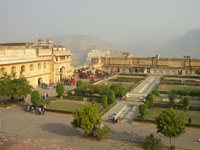
Situated on the crest of a hill seven miles (11km) north of Jaipur is Amber, capital of the Kuchwaha Rajputs from 1037 to 1728. The city-palace is protected by towering outer walls, and a further wall runs for miles along the hills surrounding the palace. For many, the most memorable part of a trip to Jaipur is the journey up the palace ramparts, through a succession of vast gates, on the back of a painted elephant, Maharaja-style. Inside are the ruins of a once-great palace: a wonderful example of Rajput architecture, with Mogul influences. Visitors will be able to see the remains of the Maharajas quarters surrounded by the rooms of his many wives and concubines, each linked to his bedroom by secret steps and passageways to avoid jealousy. Although much of the complex is closed to the public, there is still a large area to explore. Visitors are advised to spend at least a few hours here, and ideally to hire a guide who will explain the architecture and history of the palace. Don't forget to pack your camera. Photo opportunities abound at Amber Palace but note that there is a small additional fee for those who want to take photographs.
Address : Devisinghpura, Amer, Jaipur
Website : www.amberfort.org/
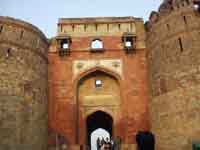
Delhi is a city of contrasts, where an elephant can overtake a snazzy Italian sports car on the streets, where commanding colonial mansions stand next to overcrowded slums, and where cows are revered but musicians are labelled 'untouchable'. The city's pace is chaotic, yet strangely relaxed, making it ideal for exploring. Visitors are almost certain to have some strange and exotic experiences. The city is full of fascinating temples, museums, mosques and forts, each with a distinctive architectural style. In Old Delhi, visitors will find a charming selection of colourful bazaars and narrow winding alleys. In comparison, New Delhi - the city created to reflect the might of the British Empire - consists of tree-lined avenues, spacious parks and sombre-looking government buildings.A great way to visit many of the sights around Delhi is on the Hop On Hop Off Bus, which leaves every 30 minutes and stops at close to 20 of Delhi's top tourist destinations. Tourists pay a once-off fee and can hop on and off at a variety of monuments, gardens, bazaars, museums and galleries. The city is also ideal as a base for visiting the Taj Mahal in Agra, and provides the best links for travelling to the hill stations in northern India.
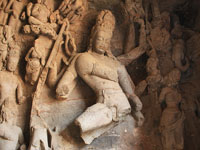
Located on Elephanta Island, in the Arabian Sea off the coast of Mumbai, the Elephanta Caves are a UNESCO World Heritage Site and an absolute must for visitors to Mumbai. The island can be reached by an hour long boat ride from the Gateway of India pier. The caves feature Shaivistic(the oldest of the four sects of Hindusm) stone sculptures of Hindu deities important to worshippers of Shiva. Many of the sculptures in the caves were unfortunately defaced by the Portuguese who, in the 17th century, used the sculptures for target practice. However, there is still lots of intricate and impressive art to see. Visitors arrive and step off the ferry to walk through a gauntlet of vendors selling all sorts of food and trinkets. It is possible to take a ride on a small train to get to the cave site, or to be carried up in chairs. The other option is simply to walk. Each year, in February, the Elephanta Dance Festival is held outside the caves with lots of local dance troupes performing. The island can get very crowded on weekends and public holidays so it is best to go during the week if possible.
Address : Elephanta Island
Website : www.elephanta.co.in/how-to-reach-elephanta-caves
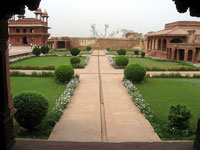
The deserted city of Fatehpur Sikri was the capital of the Mughal Empire between 1570 and 1585. It was built under the personal supervision of the Emperor Akbar. The story goes that the emperor was childless and, having tried all sorts of solutions to his plight, visited a Sufi saint, Sheikh Salim Chishti, for help. Soon a son was born, and - impressed and overjoyed - Akbar started building on the site where he had met the saint. However, due to a severe shortage of water the city was abandoned after only fifteen years, and the capital was relocated back to Agra. As a result, Fatehpur Sikri stands untouched and perfectly preserved: a complete medieval fortress built of red sandstone, with vast central squares, exquisitely carved multi-tiered pavilions, cool terraces and formal gardens. It is best to hire a guide, or do some research before visiting, because the site is hugely enriched by some knowledge of its fascinating history and the many stories that have accumulated about the place. Visitors can walk freely around the vast complex admiring the intricate architecture and carvings and imagining how the royal family once lived. The gardens are also lovely and well-maintained.
Address : Fatehpur Sikri is a 25-mile (40km) journey west of Agra, on the way to Jaipur.
Website : www.fatehpursikri.gov.in/
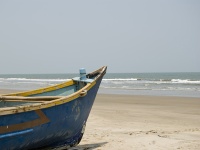
Goa has some amazing beaches, and draws a steady stream of local and international tourists.In the north, Anjuna Beach once played host to hordes of hippies, but is now home to a number of trendy beach bars as well as the famous Wednesday Market. The new hippie haven is Arambol beach, also good for dolphin-viewing and paragliding. With its white-sand beaches, Vagator is gaining in popularity. However, the sea is not safe for swimming due to the rip tides. The busiest, most commercial beach is Calangutell, while neighbouring Baga Beach has great nightlife spots.In the south, Agonda is a quiet stretch of beach with a few souvenir stalls and restaurants, while Benaulim Beach, south of Colva, is known for its fishing and laid-back atmosphere. In recent years, Benaulim has become popular with tourists wanting to get away from Goa's party reputation and just lay back, jog along the long stretch of beach and indulge in the city's fresh and healthy culinary fare. The shady palm trees and soft sands of Palolem Beach, also known as Paradise Beach, are backpacker territory. However, it's also a great place for a dolphin cruise or picturesque sundowner at one of the many beach bars lining the water. Nearby Patnem has some lovely beach huts available to rent.There are a couple of great beaches to take the kids to in Goa. The fishing village of Benaulim, near Colva, has a few quiet spots with soft sand and beautiful clean water. A firm family favourite is the Mandrem beach area, which offers shallow waters for kids to play in, and beach beds for parents to relax on. Between the beach at Mandrem and the dunes, there's a little wooden bridge crossing a river that kids love to play on.
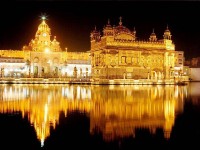
Considered one of the most beautiful temples in the world - and the veritable heart of the Sikh religion - it's no wonder that tourists come from all over the globe to see the Golden Temple of Amritsar. Situated in the middle of a sacred lake fed by an underground spring, the golden structure is a unique blend of Hindu and Muslim architectural styles. Within the temple is the Adi Grantha, the sacred scripture of the Sikhs, displayed on a jewel-studded platform.Visitors to the Golden Temple can enjoy the serene and spiritual atmosphere, with the sound of Sikh hymns accompanied by flutes, drums and stringed instruments. Next to the lake are the enormous pilgrims' dormitories; and at the gate is the information desk, where helpful and friendly staff will answer your questions and provide free pamphlets on the temple and Sikh religion.The best time to visit the Golden Temple of Amritsar is actually at night, when the Palki Sahib ceremony takes place. Dozens of devotees act as a human conveyor belt to carry the Granth Sahib (a shrine containing the Adi Grantha) from the main shrine to the sanctum, where it is kept until the opening ceremony the following morning. Visitors may participate in the ceremony, taking their turn to shoulder the weight of the enormous shrine.Visitors to the Golden Temple should be respectful of the Sikh culture. Smoking and alcohol is forbidden throughout the complex, and visitors must remove their shoes. Heads must be covered at all times - for those who forget, vendors will sell bandanas near the temple. Alternatively, it is possible to borrow a head covering from the pile kept at the entrance.
Address : Golden Temple Rd, Atta Mandi, Katra Ahluwalia, Amritsar
Website : www.goldentempleamritsar.org/
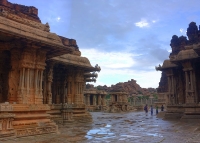
The small, relaxed town of Hampi - located in the state of Karnataka, about 220 miles (350km) from Bengaluru, and about the same distance from Panaji (in the neighbouring state of Goa) - not only boasts one of the weirdest, most awe-inspiring landscapes in the whole of India, but is also a fascinating historical site. The capital of the once-great Vijayanagar Empire, the ruins of the 14th-century village and temple complex found in present-day Hampi have been declared a UNESCO World Heritage Site. However, as impressive as these ruins are (especially the multi-tiered, ornately-sculpted Virupaksha Temple), the grandstand attraction of Hampi remains its natural landscape. A severe, desolate and boulder-strewn wilderness, tempered by a slate-grey river surrounded by lush groves of banana, mango and palm trees. Hampi might be slightly off the beaten track, but it is a manageable excursion from Bengaluru and will deeply reward all those who seek out its thoroughly singular charms. Hampi is a must for rock-climbers and is considered the bouldering capital of India.
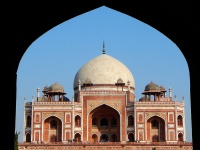
Humayun's Tomb is one of the best-preserved and most beautiful examples of Mogul architecture in Delhi, and is often seen as a forerunner of the Taj Mahal in Agra. Building started on the tomb in 1564 after the death of Humayun, the second Moghul emperor, and its construction was overseen by Haji Begum, his senior widow and the mother of Akbar. The tomb is an octagonal structure capped by a double dome that soars 125ft (38m) into the sky, and is set in a formal Persian garden. In the grounds are some other worthwhile monuments, including the Tomb of Isa Khan. Some careful restoration work has been done on some of the buildings and art but nothing important has been altered and the site has not lost its sense of authentic old age. Visiting this attraction is great for the uninitiated because it is the perfect introduction to the architecture, symbolism and importance of memorial tombs in India. For photography lovers the tomb, with its red colouring and geometric designs, is a wonderful subject. Tourist infrastructure is somewhat lacking, with only a few stalls, a tiny exhibit and no real public toilets - but, on the plus side, it is also less crowded and commercial than many other sites in the city and visitors can wander freely.
Address : Mathura Road
Website : www.humayunstomb.com/
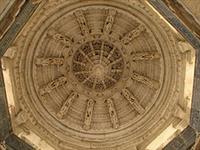
Forty miles (60km) north of Udaipur are the Jain Temples of Ranakpur. It is the largest temple complex of its kind in India, and boasts some truly staggering marble work - easily on a par with any in Asia. The main temple was built in 1439, and is dedicated to the first tirthankara Adinath, whose image is enshrined in its central sanctuary. The temple is two or three storeys high in parts, and its roof, topped with five large shikharas, undulates with tiny spires that crown the small shrines to Jain saints lining the temple walls. Within are 1444 pillars, each sculpted with unique and intricate designs, and dissecting the 29 halls. The carving on the walls, columns and the domed ceilings is superb. Friezes depicting the life of the tirthankara are etched into the walls, while musicians and dancers have been modelled out of brackets between the pillars and the ceiling. While exploring the temples at Ranakpur, visitors may see Jain monks walking about with masks on their faces to avoid eating insects. The most important teaching of Jainism is 'Ahimsa', meaning non-violence, and this is applied to all sentient beings. Many monks also carry a brush to sweep surfaces to avoid standing on bugs. Ranakpur's isolated position means it is not on the major tourist trail, but it makes a good stop for those travelling between Jaipur and Udaipur.
Address : Ranakpur, Pali district
Website : www.ranakpurtemple.com/
Kolkata is India's third-largest city, and home to some of the country's holiest temples and finest colonial structures.The 'Cultural Capital of India' is a diverse city with a diverse mixture of languages spoken among its 14 million inhabitants. It was also home to Mother Teresa, whose humble home can still be visited, and the famous writer Rabindranath Tagore. Kolkata is a city of many cultural attractions and some impressive colonial architecture. The India Museum, India's oldest, largest and arguably best museum, is a must for those interested in the history of the country. The lovely Victoria Memorial is celebrated as one of the architectural gems of the colonial period. The Marble Palace, an eccentric, privately-owned mansion with some intriguing features is also very popular.A deeply religious city representing several faiths, some striking temples often top the list of things to see in Kolkata. The Kalighat Temple is the city's holiest site, and those willing to brave the hordes of worshippers and pilgrims will find this attraction to be a profound experience. The Sri Mayapur Chandrodaya Temple, frequented by devotees of Lord Krishna, is popular with tourists; and the Dakshineshwar Kali Temple, stunning architecturally, is another favourite.
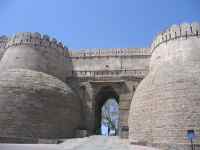
Kumbhalgarh is a massive Mewar fortress built in the 15th century, with seven heavily fortified gateways and a perimeter wall that extends a staggering 22 miles (36km); possibly the second longest continuous wall in the world. Inside this intimidating complex there are more than 360 temples (300 ancient Jain and the rest Hindu) in addition to the main palace. The fortress has immense sentimental significance for local inhabitants because it is the birthplace of Mewar's legendary king, Maharana Pratap. Needless to say, one can spend hours exploring this architectural and historical playground, and those who enjoy climbing will find many opportunities. The views from the many vantage points of this fortress are astounding.Legend has it that the maharana who built Kumbhalgarh encountered some construction difficulties and consulted a spiritual advisor who decreed that a voluntary human sacrifice would enable the project. A volunteer was eventually found and the position of the decapitated head and body signalled where building should go forward. A shrine to this unknown volunteer can still be found in the main gate.Kumbhalgarh is situated about 50 miles (82km) to the northwest of Udaipur and the drive will take about one and a half hours, making it a manageable and rewarding excursion. The fort is extremely well-maintained and the fact that it is a little remote ensures that there are seldom crowds, despite how astounding an attraction it is. There is a sound and light show in the evenings but it is conducted in Hindi.
Address : Qila Kumbhalgarh, Rajasthan 313325
Website : www.kumbhalgarhfortwalk.com/
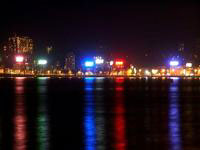
Mumbai (formerly Bombay) is India's economic powerhouse, and home to more millionaires than any other city on the Indian subcontinent. The city contains a breathtaking array of High Victorian buildings, reflecting the British passion for the Gothic and demonstrating the wealth, panache and confidence of British Bombay. Mumbai's countless attractions are reached via the iconic colonial-era arch that is the Gateway of India. Nearby stands the Taj Mahal Palace. India's second-most photographed monument, and the equally imposing Chhatrapati Shivaji Maharaj Terminus, an extravagant Gothic building.The Colaba peninsula is a hive of activity, with high-end fashion boutiques, souvenir craft markets, and a collection of restaurants and cafes. Tourists can visit the Iskcon Temple to witness scenes of intense, joyful worship accompanied by dance and music, or plan a trip to Film City to see first-hand how Bollywood shoots its films. For those seeking a break from the madness of modern Mumbai, the 180-year-old village of Khotachiwadi offers a quiet glimpse into life as it was before the high-rise buildings of today's mega-city.
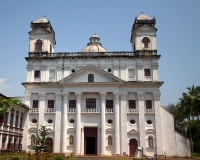
Old Goa was the state's capital city until 1843, when it was moved down river to Panaji. Once a byword for splendour, with a population of several hundred thousand, Old Goa was virtually abandoned from the 17th century, as the river silted up and a series of malaria and cholera epidemics drove out the inhabitants.It takes some imagination to picture the once-great capital as it used to be. The maze of twisting streets, piazzas and grand Portuguese villas have long gone: all that remains are a score of extraordinarily grandiose churches and convents. Old Goa has been declared a UNESCO World Heritage Site, and today is the state's main cultural attraction. Tourists take a break from the beach resorts to come and admire the massive facades and beautiful interiors of the city's well-preserved churches.The Tuscan St Catherine's Cathedral is the largest church in India and took eighty years to build, finally being consecrated in 1640. The scale and detail of the Corinthian-style interior is overwhelming: huge pillars divide the central nave from the side aisles, and no less than fifteen altars are arranged around the walls. An altar to St Anne treasures the relics of the Blessed Martyrs of Cuncolim, whose failed mission to convert the Moghul emperor Akbar culminated in their murder; while a chapel behind a highly detailed screen holds the Miraculous Cross, which stood in a Goan village until a vision of Christ appeared on it. Reported to heal the sick, it is now kept in a box; a small opening on the side allows devotees to touch it.Other sights worth seeing include the Arch of the Viceroys, built in 1597 to commemorate Vasco da Gama's arrival in India, and the distinctive, domed Church of St Cajetan (1651), modelled on St Peter's in Rome. Old Goa is a major site for Christian pilgrims from all over India who come to visit the tomb of St Francis Xavier, the renowned 16th-century missionary whose remains are enshrined in the Basilica of Bom Jesus.
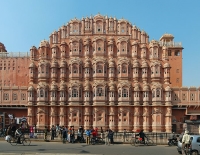
The Palace of the Winds is Jaipur's most acclaimed attraction. Built in 1799, it is situated on the edge of the City Palace complex overlooking one of the city's bustling main streets, and was constructed to offer the women of the court a vantage point, behind stone-carved screens, from which to watch the activity in the bazaars below. The five-storey building is shaped like a crown adorning Lord Krishna's head, and contains over five hundred finely-screened windows and balconies. Although the palace's primary appeal is its ornate and finely-carved pink façade, visitors can also go inside and see the intricate, honeycombed stonework of the original screens close up. There are beautiful views of the city and some surrounding forts from the inside of the building. Additional motivation for exploring the interior - apart from the thrill of imagining the royal wives and consorts flitting about behind their screens - is the naturally cool, breezy nature of the place, which makes it refreshing on hot days. Those who just want to see the building and take some photos can do so from the road without paying the entrance fee. The building is particularly lovely early in the morning when the light makes it seem even pinker than usual.
Address : Hawa Mahal Rd, Badi Choupad, J.D.A. Market, Pink City, Jaipur
Website : www.hawa-mahal.com/
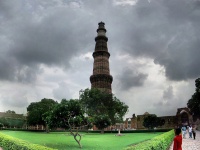
The Qutub Minar is a mammoth tower that was built between 1193 and 1369 to symbolise Islamic rule over Delhi, and to commemorate the victory by Qutab-ud-din over the city's last Hindu king. Standing 238 feet (72m) tall, the tower is decorated with calligraphy representing verses from the Quran, and tapers from 50 feet (15m) at the base to just eight feet (2.5m) at the top. There are five distinct storeys, each encircled with a balcony: the first three are built of red sandstone, and the upper two are faced with white marble.At the foot of the minhar stands Quwwat-ul-Islam, India's oldest mosque, largely built from the remains of 27 Hindu and Jain temples destroyed by the Muslim victors. The cloisters that flank the nearby courtyard are supported by pillars that were unmistakably pilfered from Hindu temples, but fascinatingly, the faces that would have adorned these pillars have been removed to conform to Islamic law, which strictly forbids iconic worship.Somewhat incongruously, in the corner of the mosque, stands the Iron Pillar, bearing 4th-century Sanskrit inscriptions of the Gupta period dedicating the structure to the memory of King Chandragupta II (373-413). It is said that anyone who can encircle the pillar with their hands whilst standing with their back to it will have their wishes fulfilled.
Address : Qutab Minar Complex, Mehrauli, nine miles (16km) from Connaught Place
Website : www.qutubminar.org/
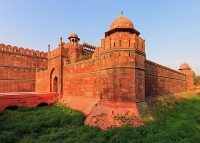
The Red Fort, known locally as Lal Quila, is Delhi's signature attraction, rising high above the clamour of Old Delhi as a reminder of the power and prosperity of the Mogul Empire. The massive sandstone walls were built in the 17th century to keep out marauding invaders, and still dominate the city's skyline today. Inside is an array of exquisite buildings, which once provided the living quarters for Shah Jehan, his courtiers, family and staff of three thousand. Visitors can marvel at the intricate decoration and only imagine the scenes here at the empire's height, when the walls were studded with precious stones and a 'stream of paradise' drove an ingenious air conditioning system. The fort was the scene of the Indian Uprising of 1857 and the mighty Lahore Gate, on the west side of the fort, remains a potent symbol of India's fight for independence. There are frequent sound and light shows in the evenings at the fort but they are conducted in Hindi; some audio guides are sometimes available to translate into French and English. The fort is vast and there is a lot to explore so it is best to allow a few hours for this famous attraction; seeing everything means covering quite a lot of ground so come prepared to do some walking.
Address : On Netaji Subhash Marg, near Chandni Chowk in Old Delhi. Entrance from Lahore Gate or Chatta Chowk
Website : www.whc.unesco.org/en/list/231

The Taj Mahal is one of the world's most recognisable and evocative sights, and despite the incredible hype, a visit here cannot disappoint. Set overlooking the River Yamuna, visible from Agra Fort in the West, the Taj was built by Shah Jahan to enshrine the body of his favourite wife, who died giving birth to her 14th child, in 1631. The story of this great monument to love is given an added poignancy by the fate of Shah Jahan himself. When his devout and austere son Aurangzeb seized power, Shah Jahan was interned in Agra Fort, where he lived out his final years gazing wistfully at the Taj Mahal in the distance. When he died there, in January 1666, with his daughter Jahanara Begum at his side, his body was carried across the river to lie alongside his beloved wife in the peerless mausoleum.Completed in 1653, the Taj Mahal is set in a large walled garden, between two mini-Taj's (one of which is a mosque), and in front of a long reflecting pond. Close up, the craftsmanship of the building is as spectacular as from a distance - the inside of the vast double-dome is inlaid with delicately-filigreed verses from the Quran and semi-precious stones. Visitors should aim to visit it at dawn and at dusk, as the building truly does change colour through the day, from rosy pink, to gleaming ivory, to twilight-blue. Note that there can often be smog and fog in the mornings. Two days before and after the full moon, the Taj Mahal is open for moonlight viewing, but tickets must be booked at least 24 hours in advance, through the Archaeological Survey of India's offices in Agra.
Address : Dharmapuri, Forest Colony, Tajganj, Agra
Website : www.tajmahal.gov.in
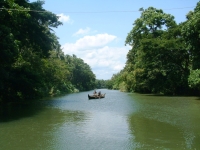
One of the most memorable experiences for many travellers in Kerala is a boat journey on the state's famous backwaters. The best-known of these areas is Kuttanad, situated between the hills in the west and the Arabian Sea, and stretching for 50 miles south of Kochi (formerly Cochin). This extraordinary maze of rivers, lakes, canals and estuaries is lined with dense tropical greenery and reveals a Keralan lifestyle that is totally hidden from the road. Boats are the only way to explore this area, billed as Kaleidoscope Kerala, where views change around every bend: narrow tree-covered canals open onto dazzling vistas of paddy fields, and through the trees can be glimpsed churches, mosques, temples, and small farms and villages which remain relatively untouched by the modern world. Buffaloes are used for ploughing the fields and women bathe and wash their clothes in the rivers. Roads do cross this area, but are almost entirely linked by manually-operated ferries rather than bridges. Kingfishers, cormorants and fish eagles compete with fisherman in rowing boats for the dwindling fish population. Providing visitors with the chance to just sit back and allow life to unfold around them at its own, slow pace, a trip on the Keralan backwaters is the ideal tonic for travel fatigue - especially if the experience of cities like Mumbai, Delhi and Kolkata has tourists feeling a bit strung out.
Address : Kerala
Website : www.keralatourism.org/destination/backwater

Varanasi has seen human settlement as far back as the 11th century BC. The 'city of light' is an intense mix of colour, sights, sounds and smells. Among many astonighing sights are the more than 100 ghats (literally 'steps') leading down into the Ganges. These are the sites of bathing and burning, where intimate rituals of life and death can be witnessed in public. Manikarnika Ghat is the most auspicious place for a Hindu to be cremated. Dasaswamedh Ghat (the 'ghat of ten sacrificed horses') is the liveliest and most colourful ghat, where every evening visitors can witness the ganga aarti (river worship) ceremony. Assi Ghat, where the river Assi meets the Ganges, is an important site of worship for pilgrims who come to pay homage to the god Shiva.Dotted around the ghats are numerous temples, the highlight being the Golden Temple, with its resplendent towers. Varanasi is world-famous for its silks, and silk brocades, and does a roaring trade with pilgrims and tourists alike. The city is home to many poets, musicians, novelists and philosophers. Visitors are strongly encouraged to spend some time in the city's tea-houses and local restaurants, where they are guaranteed to be embroiled in some fascinating conversations.
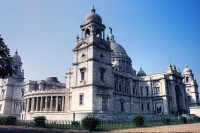
This astounding marble building is probably the most impressive colonial structure in India. In a city known for several great monuments and buildings, this palace is often considered the primary architectural gem and most iconic landmark. It was built to commemorate Queen Victoria (although she never actually visited the city) and only completed in 1921, after 20 years of solid work. Inside is a fascinating museum of Indian history, including some wonderful sculptures and paintings. The monument is situated on 64 acres of land, which includes lakes, gardens and walking paths. The gardens are well-maintained and for many the lovely grounds and exterior facade of the memorial are the highlight - the museum is fascinating for those genuinely interested in India's colonial history, but the exhibitions are informative rather than entertaining. Although the museum officially opens much later, visitors can usually get into the gardens for a small fee as early as 5:30am. This is a really beautiful time of day to visit and wonderful for photographs or morning exercise. Note that no photography is permitted inside the memorial. There is a sound and light show most evenings at 7:15pm.
Address : Queens Way, Central Kolkata
Website : www.victoriamemorial-cal.org

Travel Guide powered by Word Travels, copyright © 2023 Globe Media Ltd. By its very nature information in this travel guide is subject to change at short notice and travellers are urged to verify information on which they're relying with the relevant authorities. Neither Globe Media Ltd nor Travel Vogue can accept any responsibility for any loss or inconvenience to any person as a result of information contained above.